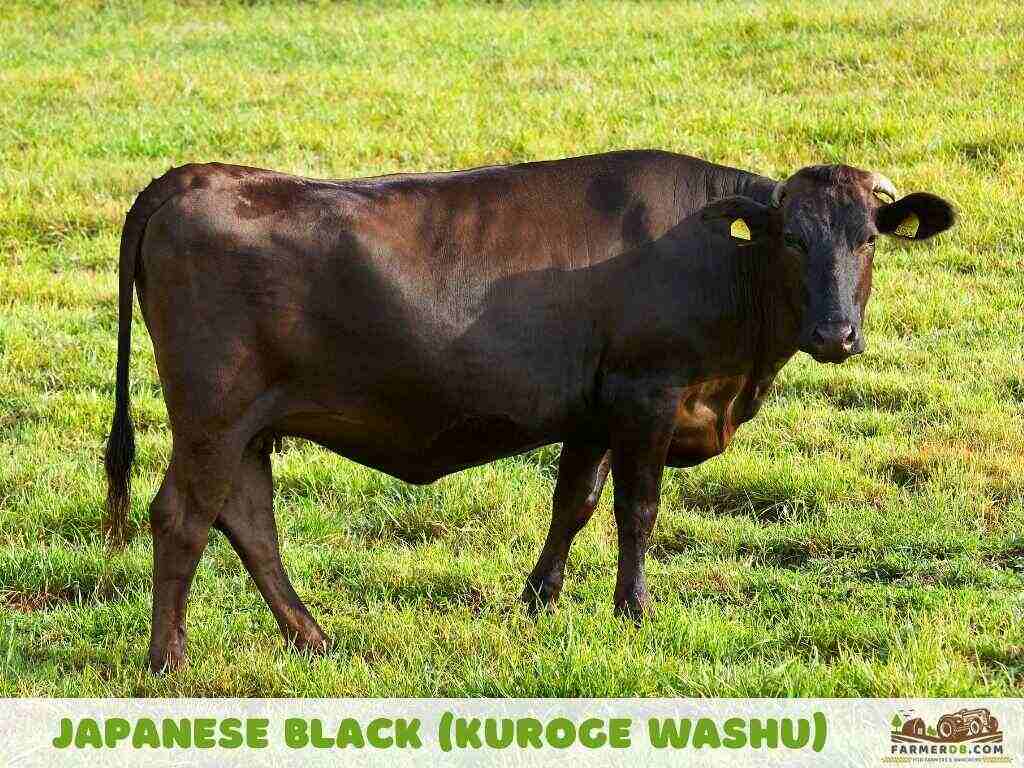Wagyu is a group of Japanese cattle breeds that are highly popular worldwide for their luxurious meat and intense marbling.
The name Wagyu (pronounced wah-gyoo) translates to “Japanese cow” (“Wa” meaning Japanese and “Gyu” meaning cow) and includes four main breeds:
- Japanese Black (Kuroge Washu)
- Japanese Brown or Japanese Red (Akage Washu or Akaushi)
- Japanese Polled (Mukaku Washu)
- Japanese Shorthorn (Nihon Tankaku Washu)
In addition to these four breeds, there are two lesser-known native Wagyu types. While the four primary breeds have been selectively improved and include some crossbreeding with European cattle, native Wagyu are purebred and have never been crossbred with any other cattle breed.
The native Wagyu are the following:
- Mishima Cattle
- Kuchinoshima Cattle
Among all Wagyu cattle, the Japanese Black breed is the most widely raised and valued for its meat quality.

Contents
History
Between 1635 and 1854, Japan did not import any foreign cattle breeds. During this period, the Japanese also did not use cattle for milk or meat due to cultural and religious beliefs. Instead, they were used only as working animals in farming and as a means of transportation.
In western Japan, people practiced selective breeding, and some of the most well-known bloodlines were the Tsuru bloodlines, which included Takenotani (Okayama), Bokura (Shimane), Iwakura (Hiroshima), and Shusuke (Hyōgo).
One of the most famous Wagyu bulls, Tajiri-go, came from the Atsuta Tsuru bloodline, which descended from Shusuke Tsuru.
According to genetic studies, 99.9% of all registered Japanese Black cattle today can be traced back to Tajiri-go.
It wasn’t until 1859 that Japan began importing cattle from the U.S., China, and Korea. By 1865, trade expanded as France, Britain, the Netherlands, and the U.S. started buying cattle from Japan.
Between 1868 and 1912, as Japan had already imported 2,600 foreign cattle, the government encouraged crossbreeding between Wagyu and Western breeds, such as Ayrshire, Simmental, and Brown Swiss.
People were disappointed with the results because the cattle were too large, slow, and had poor-quality meat. By 1912, crossbreeding was discontinued.
By 1937, the government standardized Wagyu into three main breeds: Japanese Black, Japanese Brown, and Japanese Polled. In 1957, Japanese Shorthorn was added, establishing the four official Wagyu breeds.
In 1991, Japan liberalized beef imports, making it harder for local farmers to compete with cheaper foreign beef. As a result, Japanese Black became the dominant breed due to its high marbling, while the other Wagyu breeds declined in numbers.
In 2003, Japan introduced the Beef Traceability Law, which requires all cattle to have ear tags and detailed records, allowing consumers to trace the history of any Wagyu beef sold in Japan.
Origins
Researchers have been trying for a long time to discover the exact origins of Wagyu cattle.
Some studies suggest that Wagyu developed over centuries through selective breeding between native Japanese cattle and imported breeds.
Scientists have found that Wagyu and Korean cattle come from the northern lineage, called Bos taurus, and are genetically different.
One important difference is in mitochondrial DNA haplogroups. About 65% of Japanese Black Wagyu have haplogroup T4, which is unique to East Asia and does not appear in European, Near Eastern, or African cattle.
On the other hand, 66-83% of Korean cattle have haplogroup T3, which is common in European breeds. This means that modern Korean cattle are not the main ancestors of Wagyu.
The Japanese Shorthorn, one of the four main Wagyu breeds, also has rare European Aurochs DNA, which may come from the Nanbu cattle of northeastern Japan.
In conclusion, genetic studies show that Wagyu cattle from western Japan (Japanese Black) and northeastern Japan (Nanbu cattle) have different origins, so there is no single ancestor of Wagyu.
Japanese Black (Kuroge Washu)
It began as a work animal, but this black-coated cattle has developed into the most common Wagyu breed, producing over 90% of all Wagyu beef in Japan.
Even though it is smaller and stockier than the Japanese Brown, it produces high-quality beef with rich marbling and a buttery texture.
These cattle are mainly found in the Kansai and Chūgoku regions of Japan.
Japanese Brown or Japanese Red (Akage Washu or Akaushi)
This cattle breed is the result of crossbreeding Simmental, Devon, and Hanwoo with Akaushi and was recognized as an indigenous Japanese beef cattle breed in 1944.
Today, it is primarily found in Kumamoto and Kochi Prefectures.
Larger and leaner than Japanese Black, the Japanese Brown has a lower fat content of only 12%, yet it remains rich in flavor with a firm texture.
Its population is much lower than Japanese Black, accounting for only 5% of all beef cattle raised in southern Japan.
Japanese Polled (Mukaku Washu)
The Japanese Polled cattle first appeared in 1920 when the indigenous Japanese Black was crossbred with Aberdeen Angus from England.
It is primarily found in Yamaguchi Prefecture, but compared to the other three Wagyu breeds, it is one of the rarest, with only a few hundred remaining in Japan.
Unlike other Wagyu breeds, the Japanese Polled has very little marbling, resulting in firmer meat with a more robust flavor.
Japanese Shorthorn (Nihon Tankaku Washu)
The Japanese Shorthorn was recognized as an indigenous Japanese beef cattle breed in 1957, and it is now primarily raised in northern Japan, in the Tōhoku region.
These cattle are raised differently from other Wagyu breeds. In summer, they graze on mountaintop pastures, while in winter, they are brought down to villages, where they stay in stalls and are fed winter feed.
Their meat is lean, like Japanese Polled, but it contains higher levels of amino acids and has a stronger flavor.
Although not as rare as Japanese Polled, its population is much smaller than Japanese Black. It remains a regional specialty, valued for its unique taste and nutritional qualities.
Purity Levels of Wagyu
Wagyu Crossbred / F1 (50+%)
An F1 Wagyu has at least 50% Wagyu genes and is born from a Fullblood or Purebred Wagyu bull and a mother from another breed.
Wagyu Crossbred / F2 (75+%)
A Wagyu F2 cattle comes from an F1 Wagyu mother and a Fullblood or Purebred Wagyu bull. It has over 75% Wagyu genetics, making it closer to a pure Wagyu than the previous generation.
Wagyu Crossbred / F3 (87+%)
A cattle with more than 87% Wagyu genes is classified as F3. This is also referred to as at least three generations of breeding with a pure Wagyu bull. An F3 Wagyu is born from a pure Wagyu bull and an F2 Wagyu mother.
Wagyu Purebred / F4 (93+%)
Wagyu F4 refers to a cattle that has more than 93% Wagyu genes. This happens after at least four generations of breeding with a pure Wagyu bull. An F4 Wagyu is born from a pure Wagyu bull and an F3 Wagyu mother, which is already mostly Wagyu but not completely pure.
Wagyu Fullblood (100%)
A Fullblood Wagyu comes from two purebred Wagyu parents. All of its ancestors originate from Japan, and there is no mixing with other cattle breeds.
Beyond Japan: Where Wagyu is Raised Globally
Most of these cattle are raised in Japan, which remains the leading producer of Wagyu beef in the world.
Other countries have also become interested in raising Wagyu, but not because these cattle produce more meat or are easier to raise.
In fact, Wagyu cattle yield less meat and require more care compared to other breeds. The reason farmers choose to raise them is the high market value.
The key factors in raising Wagyu include stress-free environments, specialized diets, long growth periods, and careful tracking.
Despite producing smaller quantities, Wagyu beef sells for significantly higher prices than regular beef. In this case, quality is more valuable than quantity.
Top Wagyu-Producing Countries Outside Japan
Australia – The Second Largest Producer
Australia has one of the largest fullblood and crossbred Wagyu populations outside Japan.
It might seem surprising that Australia holds this position since it only started importing Wagyu in 1990, nearly 20 years after the United States. Despite the late start, the country has expanded its Wagyu industry and now exports both grass-fed and grain-fed Wagyu to Asia, the U.S., and the Middle East.
United States – Third Largest Producer
The United States raises Wagyu cattle mainly in Texas, Idaho, and California. Unlike Australia, the U.S. focuses primarily on crossbreeding Wagyu with other cattle.
One of the most common crossbreeds is Japanese Black × Angus, known as American Wagyu, which combines high marbling with a stronger beefy flavor. Another crossbreed found in the U.S. is Japanese Brown × Angus, which produces a leaner beef option.
Other Countries Raising It
Wagyu farming has expanded to several countries worldwide, including:
- South Africa
- Brazil
- Canada
- Mexico
- China
- Indonesia
- New Zealand
- Vietnam
- Denmark
- United Kingdom
- Germany
- Netherlands
- Hungary
- Spain
- Sweden
- Ireland
Meat
When people hear Wagyu, they immediately think of highly marbled beef cuts.
This marbling is the essence of Wagyu beef, as it enhances its rich flavor, tenderness, and smooth texture.
Besides its exceptional taste, this beef is also known for its nutritional value,.
Wagyu contains monounsaturated fats, including oleic acid, which is also found in olive oil and is known for helping to lower LDL cholesterol levels. It is also a good source of omega-3 and omega-6 fatty acids, which contribute to a well-rounded nutritional profile.
A 3-ounce (85-gram) serving of cooked Wagyu beef provides approximately 243 calories, 21.3 grams of total fat (including 6.8 grams of saturated fat), and 13.7 grams of protein.
Comparison with Commercial Beef
| Aspect | Wagyu Beef | Commercial Beef |
|---|---|---|
| Marbling | Extremely high marbling | Moderate to low marbling |
| Fat Composition | Higher in monounsaturated fats, rich in oleic acid | Higher proportion of saturated fat compared to Wagyu |
| Flavor | Rich, buttery, umami flavor | Stronger, beefy taste |
| Texture | Exceptionally tender, melts in mouth | Firmer, chewier texture |
| Raising Time | Up to 36 months | 12 to 18 months |
| Feed Type | Specialized grain-fed diet (rice straw, wheat bran, corn) | Mostly corn and grain-fed, some grass-fed |
| Price per Pound | $100 – $500 per pound (premium cuts) | $5 – $25 per pound |
Beef Grading in Japan
In Japan, Wagyu beef is rated using a strict grading system approved by the Ministry of Agriculture, Forestry, and Fisheries, which evaluates both meat yield and quality.
| Yield Grade | Meat Quality Grade | ||||
|---|---|---|---|---|---|
| 5 | 4 | 3 | 2 | 1 | |
| A | A5 | A4 | A3 | A2 | A1 |
| B | B5 | B4 | B3 | B2 | B1 |
| C | C5 | C4 | C3 | C2 | C1 |
The Yield Grade (A, B, C) indicates how much usable meat is obtained from the carcass.
- A is the highest yield, with an average of 72% or more.
- B is the standard yield, ranging from 69% to 72%.
- C is the lowest yield, with values below 69%.
The Meat Quality Grade (1 to 5) is based on four factors: marbling (Beef Marbling Score – BMS), meat color and brightness, firmness, and fat quality.
Marbling (BMS – Beef Marbling Score)
- Assesses the amount and quality of intramuscular fat.
- Rated from 1 to 12, with 12 being the most marbled.
Meat Color and Brightness
- Rated from 1 to 5 (ideal color is bright red).
Firmness and Texture
- Evaluates how soft, firm, or coarse the meat is.
- Rated from 1 to 5.
Fat Quality (Color and Luster)
- Assesses fat color and shine, rated from 1 to 5.
For a final meat quality score:
- Grade 5 = All factors rated 4 or 5
- Grade 4 = All factors rated 3 or 4
- Grade 3 = All factors rated 2 or 3
- Grade 2 = One factor rated 2
- Grade 1 = One factor rated 1
The final grade is a combination of Yield (A, B, C) and Meat Quality (1 to 5).
- A5 Wagyu = The highest quality with the best yield and marbling.
- C1 Wagyu = The lowest grade with minimal meat yield and quality.
Do you have any experience with the topic discussed here?
Would you like to improve the information shared and contribute your practical knowledge on the subject?
Your real-world experience as a farmer or rancher could greatly benefit other members, and the community would deeply appreciate your contribution.


